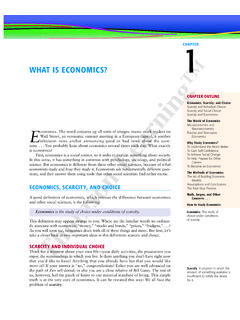Transcription of DRILLING METHODS This continuing education …
1 DRILLING METHODS This continuing education unit reviews DRILLING METHODS common to drillers, with an emphasis on water well DRILLING METHODS . For completeness mention is made of METHODS or tools used in the oil & gas industry. Often METHODS or tools first employed in the oil or gas DRILLING industry eventually find their way into the water well DRILLING field. As well mention is made of DRILLING METHODS employed in the geotechnical or environmental DRILLING sector. However the coverage of the METHODS and tool of the geotechnical or environmental sector is not exhaustive. Many drillers adopt their chosen method of both hole-making and hole clearing and become experts over time. Long and successful careers are had by working within the method of DRILLING /hole clearing chosen. These drillers identify themselves by their chosen METHODS : cable tool driller mud rotary driller, environmental/geotechnical driller.
2 Large companies look for these specialists when seeking new employees. Other drillers, by choice, or happenstance are exposed to several METHODS of making hole and hole clearing. These drillers become comfortable using different approaches depending upon hole size, engineering specifications, equipment availability and geology. The material below reviews the range of hole making and hole clearing approaches in common use in the DRILLING industry. Hole making METHODS Making hole includes breaking rock in consolidated formations and stirring sediments in unconsolidated formations. While hole making is most commonly carried out by mechanical means, other means may also be employed such as high frequency vibration and hydraulic pressure. MECHANICAL HOLE MAKING METHODS CABLE TOOL Cable tool had its beginnings 4000 years ago in China. It was the earliest DRILLING method and has been in continuous use for about 4000 years.
3 The Chinese used tools constructed of bamboo and well depths of 3000 ft. are recorded. However, wells of this depth often took generations to complete. Cable tool rigs are sometimes called pounders, percussion, spudder or walking beam rigs. They operate by repeatedly lifting and dropping a heavy string of DRILLING tools into the borehole. The drill bits breaks or crushes consolidate rock into small fragments. When DRILLING in unconsolidated formations, the bit primarily loosens material. Water, either from the formation or added by the driller, mixes the crushed or loosened particles into a slurry at the bottom of the borehole. An experienced cable tool driller feels when the accumulated slurry has reached the point where it is reducing bit penetration to an unacceptably slow level. At this point slurry is removed from the borehole by a bailer.
4 Once the slurry is removed, the bit is reinserted into the hole and DRILLING continues. Cable Tool Drill String Components: For a cable tool drill to operate the drill string must have these four components: DRILLING cable - lifts tools, turns tools, controls tool motion. Swivel socket - connects cable to tools, allows cable to unwind. Drill stem - provides weight, steadies and guides bit. Drill bit - penetrates formation, crushes and reams, mixes cuttings. Many cable tool drillers now employ Tungsten Carbide studded bits to aid in hard rock penetration. Tool joints connect the drill string components. Depending on formation the driller may add DRILLING jars to the drill string. The hammering action provided by the jars frees tools that become jammed. Jars play no part in the DRILLING process. Cable Tool Bailer A bailer is run on a separate bailing line and is inserted after the drill string is removed from the hole.
5 The bailer is used to remove slurry from the hole so that efficient penetration can continue. Cable Tool Casing Driving Equipment The driving of casing is an integral part of cable tool DRILLING . The driving force is provided by a drive clamp attached to the drill string. A wrench square is forged in the drill stem to allow for the attachment of the drive clamp. A drive shoe is attached to the bottom of the first length of casing to be driven. The drive shoe is manufactured with a hardened cutting surface at the leading edge. When fully driven into a consolidated formation a seal is created between the drive shoe and the formation. A drive head is fitted to the top of the casing to protect it against damage when being driven. Cable Tool Operation The DRILLING motion of the cable tool DRILLING machine must be synchronized with the gravity fall of the tools for effective penetration.
6 Effective DRILLING action is obtained when the engine speed is synchronized with the fall of the tools and the stretch of the cable, while paying out the correct amount of cable to maintain proper feed of the bit. A shock absorber is installed at the crown sheave to provide resiliency in the system. The shock absorber dampens vibration and protects the derrick and machine from severe shock stresses. The shock absorbers rebound helps to lift the tools sharply after they strike bottom. Every cable tool machine has certain limits as to the depth and diameter of boreholes it is capable of DRILLING . This limit is a function of the total weight of the drill string plus the cable needed to drill to either maximum depth or maximum casing diameter. The usual process is to drive the casing initially using the hammering action of the drive clamps attached to the wrench square near the top of the drill stem.
7 The clamps act as the hammer face and the tools provide the weight for driving the casing. After the casing is driven into the formation, the material is removed by inserting the bit, adding water and operating the drill bit until a slurry is formed from the cuttings. The bailer is then used to remove the slurry and this process is repeated with the driving of casing the insertion of the drill bit, the operation of the bit until a slurry is formed and the bailing of the slurry until the casing reaches a desired depth. While DRILLING , a depth may be reached where casing cannot be driven further without risking damage to it. If this point is reached and sufficient water has not yet been found, the casing diameter will then be reduced and DRILLING will continue inside the smaller casing. Drillers anticipating the need to telescope casing downward will begin DRILLING a borehole of a larger size to accommodate telescoping down during the DRILLING process.
8 Advantages of the cable tool: 1. Highly suitable for remote settings. The cable tool s low fuel consumption, small needs for water and other materials and reliability make it an excellent choice for remote site locations. 2. Low capital investment and cheap maintenance. Capital costs of new cable tool rigs are generally significantly less than the costs of new rotary DRILLING machines of similar capacity. As well, cable tool maintenance is less expensive than parts for the less mechanical, more hydraulically equipped rotary systems. 3. Particularly suited to water poor areas. Cable tool DRILLING more easily identifies each water bearing formation penetrated, even those of small yields. 4. Efficient use of personnel. Cable tool rigs are often operated by a single person. Disadvantages of Cable tool DRILLING : 1. Productivity measured in hole produced per day is low compared to other DRILLING METHODS in similar formations. 2. Hard rock penetration rates very low.
9 Despite many new DRILLING developments, cable tool remains a useful and competitive DRILLING technique in some DRILLING applications. AUGER DRILLING Often used for site investigation, environmental and geotechnical DRILLING and sampling, and boreholes for construction purposes, auger DRILLING can be an efficient DRILLING method. The advantages of auger DRILLING include low operating costs, fast penetration rates in suitable formations and no contamination of samples by fluids. Augers come in continuous flight, short flight/plate augers and bucket augers. Continuous flight augers driven by top head rotary machines (shown above) carry their cuttings to the surface on helical flights. Continuous flight augers with hollow stems are often used for sample recovery in environmental, geotechnical operations. Short flight/plate augers and bucket augers are used for large diameter holes.
10 The cuttings are lifted out of the hole and then removed before DRILLING continues. Rotary DRILLING Rotary DRILLING uses a sharp, rotating drill bit to dig down through the Earth's crust. Much like a common hand held drill, the spinning of the drill bit allows for penetration of even the hardest rock. The idea of using a rotary drill bit is not new. Archeological records show that as early as 3000 , the Egyptians may have been using a similar technique. Leonardo Di Vinci, as early as 1500, developed a design for a rotary DRILLING mechanism that bears much resemblance to technology used today. Despite these precursors, rotary DRILLING did not rise in use or popularity until the early 1900's. Although rotary DRILLING techniques had been patented as early as 1833, most of these early attempts at rotary DRILLING consisted of little more than a mule, attached to a DRILLING device, walking in a circle!






